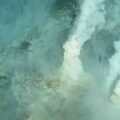No one knew the source of the odd, repeating noises coming from somewhere in the ocean depths off the New Zealand coast.
It was July 1982, and experiments were underway to use hydrophones to collect data about the soundscape of New Zealand’s South Fiji Basin.
Then, the “Quackers” arrived.
When the researchers heard it, the sound usually manifested as a series of four quick bursts, producing an almost comical noise resembling a quack. The researchers gave it a name: “Bio-Duck.”
“The sound was so repeatable, we couldn’t believe at first that it was biological,” remembers Ross Chapman, a researcher with the University of Victoria, Australia, who remains perplexed by the strange sounds after many decades.
However, shortly after they were initially detected, Chapman and his colleagues would soon learn that they weren’t the only ones hearing them: several others had encountered the sound in the coastal waters around New Zealand and Australia.
Although theories about their origin varied, one thing seemed clear: the source of the strange “quacks” haunting New Zealand’s coastal waters appeared to be coming from some kind of living animal.
To date, the source of the strange noises remains unidentified.
The Curious Case of the Cold War “Quackers”
For many decades, strange sounds of undetermined origin have been recorded in various parts of the world’s oceans.
During the height of the Cold War, U.S. and Soviet intelligence efforts included monitoring from beneath the ocean’s surface, where each country’s nuclear submarines became key tools for surveillance and counterintelligence. From radar interception to undersea cable tapping and acoustic signal analysis, a variety of clandestine missions were undertaken by the major superpowers from deep within the seas.
Among the more intriguing stories that were later told by Soviet naval officers were tales of encounters with mysterious underwater phenomena that produced strange noises when tracked on sonar systems. Dubbed “Quackers” (also occasionally translated as quakers, and not explicitly linked to the sounds recorded near New Zealand in the 1980s), these mysterious undersea anomalies were recounted by the likes of Vladimir Shigin, a former Russian Navy Captain 1st Rank, who later detailed the encounters he and other Russian Navy officers shared during their years at sea in his book Ghost on Watch.
Shigin wrote of the incidents, which reportedly involved unidentified “incomprehensible objects” detected on sonar that would sometimes pace the Soviet submarine vessels, even encircling them as though engaged in monitoring operations, or perhaps simply exhibiting curiosity.
When the strange objects would leave, they often made their departure at high speed, movement that produced an audible artifact on the sonar systems which resembled the croaking of a frog. While the resulting English term for these phenomena used by Russian naval officers would have effectively been croakers, somewhere along the way there seem to have been enough confused translations to have propagated the “Quacker” moniker instead.
“Those who heard them always had a strong impression of completely conscious actions,” Shigin would later recall of the strange encounters, noting that the Quackers sometimes seemed to mimic sonar communications when they would appear. At times, Shigin said he and his fellow officers even had the distinct impression the objects “were persistently trying to establish contact with our submarines.”
“Judging by the continuously changing bearing, they circled around the submarines,” Shigin later wrote, “but changing the tone and frequency of the signals, they seemed to provoke the submariners into a kind of dialogue, reacting especially actively to hydroacoustic ‘parcels’ from the boats.” During some of the encounters, the objects would seemingly accompany the Soviet submarines for extended periods, following alongside them before ultimately disappearing.
Shigin said there was never any aggressiveness shown by the objects, and that he and others were even given the impression that these objects, whatever they were, had been “deliberately demonstrating their peacefulness.”
Still, the presence of the Quackers caused unease among the Russian submarine crews, who feared at the time that they might represent some kind of advanced U.S. anti-submarine technologies, although no evidence ever emerged to substantiate such ideas. Despite exhaustive investigations by Soviet naval teams in the 1970s, including expeditions and signal decoding attempts, the phenomenon remained unexplained. As the stories emerged over the ensuing decades, the mysterious nature of the incidents gave rise to alternative theories about what the objects might have been, ranging from the possibility of an unknown marine species to underwater UFOs.
The “Bloop” Enigma
After the Cold War, a few technologies leftover from the undersea surveillance efforts of the period would later be recycled for use by scientists. These include the U.S. Navy Sound Surveillance System (SOSUS), a network of hydrophones originally deployed for espionage that were eventually complimented by the Equatorial Pacific Ocean autonomous hydrophone array developed by NOAA’s Pacific Marine Environmental Laboratory.
Beginning in the mid 1990s, a series of unusual sounds were detected with NOAA’s hydrophone system. One of these peculiar noises, first recorded in 1997 and seemingly traced to a remote area in the South Pacific Ocean, involved an ultra-low frequency sound that researchers nicknamed “Bloop.” Due to its rapid frequency variation, Bloop bore some similarity to the calls of various marine animals, prompting speculation that the noise might have been produced by some as-yet unrecognized form of marine life.
However, there were problems with the marine life theory for Bloop’s origins. At the time of its detection, this anomalous deep-sea noise had been independently registered on sensors located 4800 kilometers apart, meaning that its source must have been exceptionally strong for it to have been biological in origin. Given Bloop’s similarity to some vocalizations associated with whales, the strength of the sonic signal raised an intriguing question: was it possible that an unrecognized animal somewhere in the depths of the South Pacific Ocean was producing this sound, and not only that, but an extremely large one?
For many years, the mystery of Bloop lingered, along with the haunting possibility entertained by some that an unknown behemoth might be lurking in Earths’ deep oceans. Several years of study would follow before, in 2005, NOAA came to an entirely different conclusion: it was more likely that Bloop had been related to cryoseisms, a kind of seismic phenomenon associated with sudden, often explosive events that occur when ice undergoes cracking or large-scale movement, such as with glaciers.
In the case of glacial movement, such events can generate very powerful, low-frequency sounds that are able to propagate very efficiently through water—particularly in the SOFAR channel, a region of ocean water that exists at a depth that causes it to function as a waveguide for sound, allowing the propagation of low frequency sound waves over extremely long distances before their dissipation. Adding further weight to the cryoseism theory for Bloop’s origins had been the disintegration of iceberg A53a near South Georgia Island in 2008, which produced sonic signatures very similar to Bloop.
Unraveling the Mystery of the New Zealand Noises
Although the mysteries surrounding a few of the curious ocean sounds recorded over the decades have been solved, others like the strange quack-like “communication” Ross Chapman and his colleagues overheard while monitoring undersea noise off the coast of New Zealand in the 1980s remain mysterious, at least for now.
Earlier this month, during the 187th Meeting of the Acoustical Society of America held online, Chapman showcased his ongoing analysis of the mysterious oceanic sounds he and his colleagues documented many decades ago, noting how modern advancements in acoustic analysis could ultimately help researchers like him narrow in on a solution to the longstanding mystery.
“You have to understand that this type of study of ocean noise was in its infancy in those days,” Chapman recently said. “As it turned out, we learned something new about sound in the ocean every day as we looked further into the data—it was really an exciting time for us.”
Despite everything Chapman and his colleagues have learned, the source of the curious “conversations” they managed to eavesdrop on in 1986 remains undetermined. Current ideas about their origin include the calls of Antarctic Minke whales, a theory proposed in April 2014. Although Chapman says that there were no visual sightings to help corroborate this possibility, he nonetheless feels confident that the noises—whatever their source—were some kind of communication.
“We discovered that there were usually several different speakers at different places in the ocean, and all of them making these sounds,” Chapman said.
“The most amazing thing was that when one speaker was talking, the others were quiet, as though they were listening,” Chapman added. “Then the first speaker would stop talking and listen to responses from others.”
For Chapman, the source of the mysterious ocean communications—whether they were produced by whales, or something else entirely—has remained baffling.
“It’s always been an unanswered issue in my mind,” Chapman said, wondering about what the meaning behind the strange sounds from 1986, regardless of their source.
“Maybe they were talking about dinner, maybe it was parents talking to children.”
“Or maybe,” Chapman mused, “they were simply commenting on that crazy ship that kept going back and forth towing that long string behind it.”
Micah Hanks is the Editor-in-Chief and Co-Founder of The Debrief. He can be reached by email at micah@thedebrief.org. Follow his work at micahhanks.com and on X: @MicahHanks.

